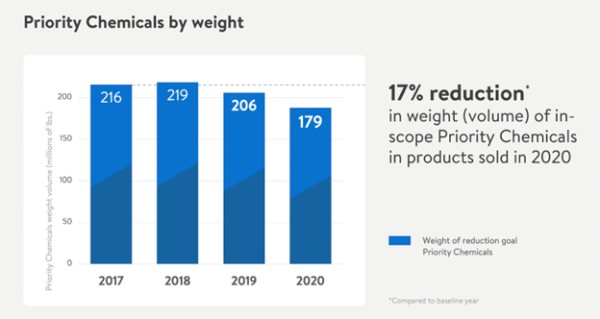A few weeks ago, Walmart dropped some big news in its sustainability report: the company reduced its toxic chemical footprint!
In 2023, toxic priority chemicals tracked by Walmart made up 2.03% of the company’s “formulated consumable products” by weight. That means just over 2% of ingredients in formulated personal care, baby, pet, and household cleaning products by weight were made up of troubling hazardous chemicals.
Now, Walmart’s sustainability team has reduced the toxic chemical intensity of these products to 1.69%—a decline of 0.34 percentage points between 2023 and 2024.

Source: Walmart.com
That may not sound like a lot, but for a corporation as big as Walmart, those percentage points add up! This progress matters because certain chemicals—particularly endocrine disruptors such as phthalates—can be hazardous even at very low levels of exposure. It’s also very welcome news because it corrects for two years of regrettable backsliding.
Walmart’s chemical reduction efforts and past setbacks
Walmart has consistently scored very well in our Retailer Report Card, due in part to its commitment to measuring its chemical footprint and the company’s groundbreaking 2017 goal to reduce that footprint by 10% over five years. Walmart was the first retailer to make a commitment like this and remains the only retailer to report on its progress publicly.
The company tracks its progress by screening more than 4,000 priority chemicals across 60,000 formulated products annually—a far broader scope of chemicals and products than most retailers. In fact, Walmart surpassed its goal, achieving a reduction of 17%.
However, in the three years since this victory, Walmart’s toxic chemical intensity has been on the rise. While this year’s reduction doesn’t quite return to the company’s record lows, it shows meaningful progress—as a result of Walmart’s successful efforts to reformulate private label and brand name products, launch new products without priority toxic chemicals, and encourage its suppliers to do the same.
Why the missing data matters
The forecast isn’t all rosy—Walmart’s announcement is sparser than in previous years, excluding meaningful data metrics such as the company’s total chemical footprint in pounds.
Walmart previously disclosed there were 179 million pounds of toxic chemicals in its products, which was a reduction of 37 million from its 2017 baseline (see the graph below), but we no longer know how the chemical weight stacks up today.

Source: Walmart.com
The new percentage reduction is significant, but the total amount of hazardous chemicals is equally critical data for consumers who want to know just how many pounds of these chemicals enter our homes each year.
A large portion of the formulated products being measured are beauty and personal care products, as well as cleaning products, which all eventually make their way down the drain and into the environment—which is yet another reason to track the total pounds of hazardous chemicals.
Walmart’s sustainability report still shares the total estimated pounds of cardboard and plastic it recycles and the total expected metric tons of carbon dioxide reduced.
Families need the same transparency around toxic chemicals.
Steps Walmart can take to continue to reduce its chemical footprint
Public goals drive accountability—essential for a company aiming to provide products that keep communities safe and healthy. To keep up its leadership role, Walmart should set a new public goal to reduce its chemical footprint.
Walmart successfully uses public goals in other areas like Project Gigaton, which aims to cut or sequester 1 billion metric tons of carbon dioxide by 2030. In fact, Walmart just recently announced a new public goal to remove artificial food dyes and additives from its store brands by 2027.
We recommend Walmart commit to reducing its chemical footprint by 50% within the next five years and require suppliers to evaluate the hazards of alternatives to priority chemicals to avoid regrettable substitutes. If these suggestions sound familiar, that’s because we’ve offered them to Walmart before.
Leaders don’t rest on their laurels.
A win for safer products nationwide
Walmart’s reduction is a notable success and comes on a wave of fresh momentum for getting toxic chemicals out of everyday products.
Washington state just announced a landmark ban restricting formaldehyde releasers in personal care products, a huge victory for everyone, and especially for people of color and salon workers who face the highest exposure. Legislation restricting PFAS and other hazardous chemicals are gaining ground across the country as states lead the way.
Walmart’s announcement shows us progress is possible, and that retailers don’t need to sacrifice market success in order to achieve change.
This should be a call to action for all retailers to step up and eliminate hazardous chemicals—or else risk getting left behind by competitors that take a stand against toxics.





